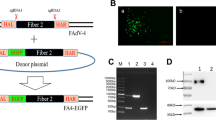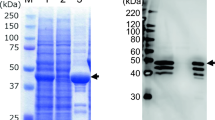Abstract
Inclusion body hepatitis and hepatitis–hydropericardium syndrome caused by high-pathogenic fowl adenovirus serotype 4 has recently plagued Chinese poultry industry and caused huge economic losses since 2013. So far, there is no commercial vaccine available to control this disease. In this study, we reported the development of both embryo-adapted and cell-culture derived inactivated FAdV-4 vaccines and evaluated their efficacies in chicken. Compared to embryo-adapted vaccine, cell-culture derived vaccine induced significantly earlier and higher serological response measured by AGP and ELISA. After virus challenge, chicken immunized with cell-culture derived vaccine did not showed any gross and histopathological lesions, whereas inclusion body hepatitis was observed in the liver of chicken vaccinated with embryo-adapted vaccine. No mortality was observed in both the vaccinated groups. The above results suggested that cell-culture derived FAdV-4 inactivated vaccine could be a better vaccine candidate than embryo-adapted vaccine to control FADV-4 infections in China.



Similar content being viewed by others
References
Anjum AD, Sabri MA, Iqbal Z. Hydropericarditis syndrome in broiler chickens in Pakistan. Vet Rec. 1989;124(10):247–8.
Asthana M, Chandra R, Kumar R. Hydropericardium syndrome: current state and future developments. Adv Virol. 2013;158(5):921–31. doi:10.1007/s00705-012-1570-x.
Benkö MHB, Both GW, Russell WC, Adair BM, Ádám É, et al. Adenoviridae. In: Fauquet CMMM, Maniloff J, Desselberger U, Ball LA, editors. Virus taxonomy, VIIIth report of the international committee on taxonomy of viruses. London: Academic Press; 2005. p. 213–28.
Chen CW, Lee YP, Wang YF, Yu CK. Formaldehyde-inactivated human enterovirus 71 vaccine is compatible for co-immunization with a commercial pentavalent vaccine. Vaccine. 2011;29(15):2772–6. doi:10.1016/j.vaccine.2011.01.094.
Cowen BS. A trivalent antigen for the detection of type I avian adenovirus precipitin. Avian Dis. 1987;31(2):351–4.
Dahiya S, Srivastava RN, Hess M, Gulati BR. Fowl adenovirus serotype 4 associated with outbreaks of infectious hydropericardium in Haryana, India. Avian Dis. 2002;46(1):230–3. doi:10.1637/0005-2086(2002)046[0230:FASAWO]2.0.CO;2.
Domanska-Blicharz K, Tomczyk G, Smietanka K, Kozaczynski W, Minta Z. Molecular characterization of fowl adenoviruses isolated from chickens with gizzard erosions. Poult Sci. 2011;90(5):983–9. doi:10.3382/ps.2010-01214.
Dormitzer PR, Tsai TF, Del Giudice G. New technologies for influenza vaccines. Hum Vaccin Immunother. 2012;8(1):45–58. doi:10.4161/hv.8.1.18859.
Dupuy HJ, Blouse LE, Marraro RV. Evaluation of agar-gel double diffusion for the diagnosis of adenovirus infection. Appl Microbiol. 1973;25(6):1013–4.
Gomis S, Goodhope AR, Ojkic AD, Willson P. Inclusion body hepatitis as a primary disease in broilers in Saskatchewan, Canada. Avian Dis. 2006;50(4):550–5. doi:10.1637/7577-040106R.1.
Kim JN, Byun SH, Kim MJ, Kim J, Sung HW, Mo IP. Outbreaks of hydropericardium syndrome and molecular characterization of Korean fowl adenoviral isolates. Avian Dis. 2008;52(3):526–30. doi:10.1637/8178-112207-Case.
Kim MS, Lim TH, Lee DH, Youn HN, Yuk SS, Kim BY, et al. An inactivated oil-emulsion fowl Adenovirus serotype 4 vaccine provides broad cross-protection against various serotypes of fowl Adenovirus. Vaccine. 2014;32(28):3564–8. doi:10.1016/j.vaccine.2014.03.015.
Li H, Wang J, Qiu L, Han Z, Liu S. Fowl adenovirus species C serotype 4 is attributed to the emergence of hepatitis–hydropericardium syndrome in chickens in China. Infect Genet Evol. 2016;2016(45):230–41. doi:10.1016/j.meegid.09.006.
Lim TH, Lee HJ, Lee DH, Lee YN, Park JK, Youn HN, et al. Identification and virulence characterization of fowl adenoviruses in Korea. Avian Dis. 2011;55(4):554–60. doi:10.1637/9730-032011-Reg.1.
Lim TH, Kim BY, Kim MS, Jang JH, Lee DH, Kwon YK, et al. Outbreak of gizzard erosion associated with fowl adenovirus infection in Korea. Poult Sci. 2012;91(5):1113–7. doi:10.3382/ps.2011-02050.
Mansoor MK, Hussain I, Arshad M, Muhammad G. Preparation and evaluation of chicken embryo-adapted fowl adenovirus serotype 4 vaccine in broiler chickens. Trop Anim Health Prod. 2011;43(2):331–8. doi:10.1007/s11250-010-9694-z.
Mittal D, Jindal N, Tiwari AK, Khokhar RS. Characterization of fowl adenoviruses associated with hydropericardium syndrome and inclusion body hepatitis in broiler chickens. Virusdisease. 2014;25(1):114–9. doi:10.1007/s13337-013-0183-7.
Nakamura K, Mase M, Yamaguchi S, Shibahara T, Yuasa N. Pathologic study of specific-pathogen-free chicks and hens inoculated with adenovirus isolated from hydropericardium syndrome. Avian Dis. 1999;43(3):414–23.
Nakamura K, Mase M, Yamaguchi S, Yuasa N. Induction of hydropericardium in one-day-old specific-pathogen-free chicks by adenoviruses from inclusion body hepatitis. Avian Dis. 2000;44(1):192–6.
Niu YJ, Sun W, Zhang GH, Qu YJ, Wang PF, Sun HL, et al. Hydropericardium syndrome outbreak caused by fowl adenovirus serotype 4 in China in 2015. J Gen Virol. 2016;. doi:10.1099/jgv.0.000567.
Ono M, Okuda Y, Shibata I, Sato S, Okada K. Reproduction of adenoviral gizzard erosion by the horizontal transmission of fowl adenovirus serotype 1. J Vet Med Sci. 2007;69(10):1005–8.
Partridge J, Kieny MP. Global production capacity of seasonal influenza vaccine in 2011. Vaccine. 2013;31(5):728–31. doi:10.1016/j.vaccine.2012.10.111.
Schachner A, Marek A, Jaskulska B, Bilic I, Hess M. Recombinant FAdV-4 fiber-2 protein protects chickens against hepatitis–hydropericardium syndrome (HHS). Vaccine. 2014;32(9):1086–92. doi:10.1016/j.vaccine.2013.12.056.
Schonewille E, Jaspers R, Paul G, Hess M. Specific-pathogen-free chickens vaccinated with a live FAdV-4 vaccine are fully protected against a severe challenge even in the absence of neutralizing antibodies. Avian Dis. 2010;54(2):905–10. doi:10.1637/8999-072309-Reg.1.
Shah MS, Ashraf A, Rahman M, Khan MI, Qureshi JA. A subunit vaccine against hydropericardium syndrome using adenovirus penton capsid protein. Vaccine. 2012;30(50):7153–6. doi:10.1016/j.vaccine.2012.10.013.
Shivachandra SB, Sah RL, Singh SD, Kataria JM, Manimaran K. Immunosuppression in broiler chicks fed aflatoxin and inoculated with fowl adenovirus serotype-4 (FAV-4) associated with hydropericardium syndrome. Vet Res Commun. 2003;27(1):39–51.
Vera-Hernandez PF, Morales-Garzon A, Cortes-Espinosa DV, Galiote-Flores A, Garcia-Barrera LJ, Rodriguez-Galindo ET, et al. Clinicopathological characterization and genomic sequence differences observed in a highly virulent fowl Aviadenovirus serotype 4. Avian Pathol. 2016;45(1):73–81. doi:10.1080/03079457.2015.1125443.
Winterfield RW, Fadly AM, Gallina AM. Adenovirus infection and disease. I. Some characteristics of an isolate from chickens in Indiana. Avian Dis. 1973;17(2):334–42.
Xie Z, Luo S, Fan Q, Xie L, Liu J, Xie Z, et al. Detection of antibodies specific to the non-structural proteins of fowl adenoviruses in infected chickens but not in vaccinated chickens. Avian Pathol. 2013;42(5):491–6. doi:10.1080/03079457.2013.829553.
Ye J, Liang G, Zhang J, Wang W, Song N, Wang P, et al. Outbreaks of serotype 4 fowl adenovirus with novel genotype, China. Emerg Microbes Infect. 2016;5:e50. doi:10.1038/emi.2016.50.
Zhao J, Zhong Q, Zhao Y, Hu YX, Zhang GZ. Pathogenicity and complete genome characterization of fowl adenoviruses isolated from chickens associated with inclusion body hepatitis and hydropericardium syndrome in China. PLoS ONE. 2015;10(7):e0133073. doi:10.1371/journal.pone.0133073.
Acknowledgement
This work was supported by Grant from Luoyang Heluo Talent Plan (Dr. Kegong Tian).
Author information
Authors and Affiliations
Corresponding authors
Rights and permissions
About this article
Cite this article
Du, D., Zhang, P., Li, X. et al. Cell-culture derived fowl adenovirus serotype 4 inactivated vaccine provides complete protection for virus infection on SPF chickens. VirusDis. 28, 182–188 (2017). https://doi.org/10.1007/s13337-017-0372-x
Received:
Accepted:
Published:
Issue Date:
DOI: https://doi.org/10.1007/s13337-017-0372-x




